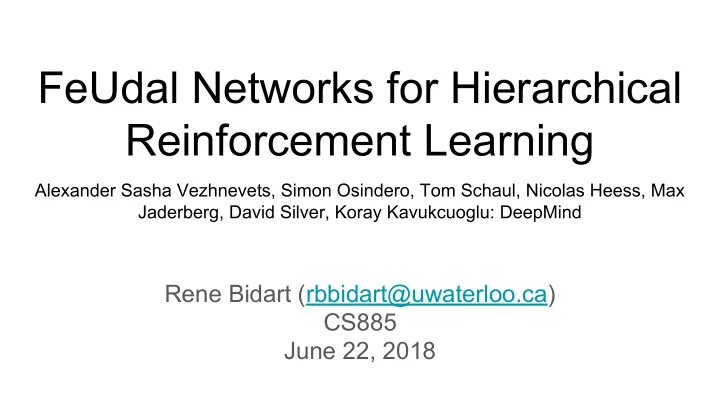

FeUdal Networks for Hierarchical Reinforcement Learning Alexander Sasha Vezhnevets, Simon Osindero, Tom Schaul, Nicolas Heess, Max Jaderberg, David Silver, Koray Kavukcuoglu: DeepMind Rene Bidart (rbbidart@uwaterloo.ca) CS885 June 22, 2018
Why do we care about HRL? Reinforcement Learning is hard! ● Long time horizons and sparse rewards are problematic for current methods ● Many of the methods we use are not intuitively appealing ● Look to human decision process for inspiration
Hierarchies How do we make decisions? ● If we are hungry, do we reason in terms of small muscle movements? ● To play the guitar, do we randomly jitter our fingers until we play a song? No, we reason using hierarchies of abstraction. ● We already use conv nets to learn hierarchical structure in images. Why not use hierarchical structure in policies?
Feudalism ● Governance system in Europe in middle ages ● Extremely hierarchical, based on ownership of property ● Higher level people have control over the lower levels, but not over people many layers lower
Feudal RL (1993) Rewards Reward Hiding : Agent ● Managers reward sub-managers for satisfying Rewards their commands, not through an external reward Agent ● Managers have absolute control Rewards Information Hiding ● Observe world at different resolutions Agent ● Managers don’t know what happens at a other Actions levels of the hierarchy Environment
Feudal RL (1993) ● Q-learning ● Used to solve a simple maze task ● Didn’t generate good results on more complex or less obviously hierarchical problems
FeUdal Networks (2017): Overview Rewards Manager Manager ● Sets directional goals for the worker ● Rewarded by environment ● Does not directly act in environment Goals, Rewards Worker Worker ● Higher temporal resolution Actions ● Reward for achieving manager’s goals Environment ● Produces primitive actions in environment
FeUdal Networks (2017): Overview Rewards Architecture Manager ● Both worker and manager share a state embedding ● Both worker and manager use RNNs Goals, Rewards Goals Worker ● Manager produces directional goals for Actions worker in latent space Environment ● Trained using novel transition policy gradient
FeUdal Network: Details
FeUdal Network Shared Dense Embedding ● Embedding of input state ● Used by both worker and manager to produce goal and action ● CNN ○ 16 8x8 filters ○ 32 4x4 filters ○ 256 fully connected ○ ReLU
FeUdal Network Manager: Goal embedding ● Lower Temporal Resolution, goals summed over last 10 time steps ● Uses dilated LSTM ● Goal is in low-dimensional space, not environment ● Trained using transition policy gradient
FeUdal Network Worker: Action Embedding ● LSTM on shared embedding ● Embedding U matrix: ○ Rows: actions [a] ○ Columns : embedding dimension [k]
FeUdal Network Goal embedding: Worker ● Compress manager’s goal to dim k using linear transformation - ɸ ● Same dim as action embedding ● Linear transformation with no bias ○ Can’t produce a 0 vector ○ Can’t ignore the manager’s input, so manager’s goal will influence final policy
FeUdal Network Action: Worker ● Product of action embedding matrix (U) with goal embedding (w) ● Produces a distribution over actions ● Action = softmax(U*w)
Training Manager: Transition Policy Gradient ● Worker’s goal is directional, rather than absolute ● Instead of increasing the probability of an action, we shift the direction of the goal Actor-critic: Value function from internal critic:
Training: Worker’s Intrinsic Reward ● Intrinsic reward is based on if the worker follows the correct direction
Training: Worker’s Intrinsic Reward Actor-Critic: Reward isn’t truly hierarchical ● They use weighted sum of intrinsic reward, and environment reward
Why directional goals? Feasibility ● Worker can more easily cause directional shifts, rather than reaching a new location in state space Structural Generalization ● A single sub goal (direction) can be useful in many different locations in the state space
More Details: Dilated LSTM ● Better able to preserve memories over long periods ● Output is summed over previous 10 steps ● Specific type of Dilated RNN Dilated RNN [Chang et al. 2017]:
Results: Atari ● Outperforms LSTM baseline whenever there are more delayed rewards
Results : Water Maze ● Circular space with invisible goal, agent must find goal ● Next episode put in a random location, and agent must find goal again ● Left are individual episodes, right visualizes the sub-policies ● Agent learns meaningful sub goals
Results: Temporal Resolution Ablations ● Removing dilations from the LSTM or using full temporal time scale for manager is significantly worse
Results: Intrinsic Reward Ablations ● Using only intrinsic reward at right ● Environment reward is not necessary for good performance
Results: Atari Action Repeat Transfer ● One of the goals of HRL was better transfer learning ● Transfer learning with different number of action repeats ● Manager’s policy does not depend on how the worker achieves these goals
Summary ● Directional rather than absolute goals are useful ● Dilated LSTM is crucial for high performance ● Improves long-term credit assignment over baselines ● Improves transfer across different action repeats ● Manager’s goals are meaningful low-level behaviors from the worker
Thoughts ● Ablation studies were crucial to get a better idea what is going on - something missing in a lot of DL papers. ● Why does worker produce goal and action embedding, rather than just feeding it into a fully connected network?
Questions?
Recommend
More recommend